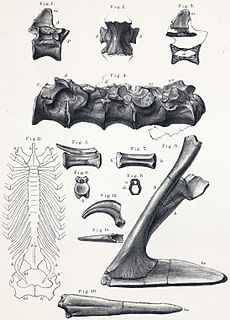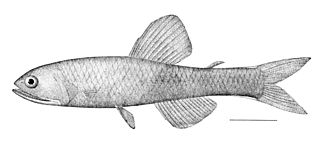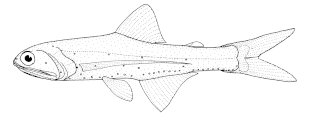The least gerbil is distributed mainly in South Sudan, southwestern Ethiopia, Kenya, and Tanzania.

Aristosuchus is a genus of small coelurosaurian dinosaur whose name was derived from the Greek ἄριστος and σουχος. It shared many characteristics with birds.

Lampanyctus is a genus of lanternfishes.

The southern lanternfish, Lampanyctus australis, is a lanternfish of the family Myctophidae, found circumglobally in the southern hemisphere between 33° S and 44° S, mainly at below 500 m. Its length is about 13 cm. It is an oceanic mesopelagic species, eaten by hakes, kingklip and Cape horse mackerel.

The blurred lanternshark is a little-known species of dogfish shark in the family Etmopteridae, found around the world in benthic and pelagic habitats from a depth of 110 m (360 ft) to over 1 km (0.62 mi) down. This shark forms the E. pusillus species group with the smooth lanternshark, which are distinguished from other members of its family by having irregularly arranged, flat-topped dermal denticles that give them a "smooth" appearance. Both species are slender-bodied with long heads, two dorsal fins bearing spines, no anal fins, and light-emitting photophores. The blurred lanternshark is larger, reaching 67 cm (26 in) or more in length. This species feeds on small squid, fishes, and fish eggs, and is ovoviviparous. It has been assessed as of Least Concern by the International Union for Conservation of Nature, because of its wide distribution and lack of threat from fishing pressure.

The smooth lanternshark or slender lanternshark is a species of dogfish shark in the family Etmopteridae, found widely in the Atlantic and Pacific Oceans. It inhabits benthic environments at a depth of 274–1,000 m (899–3,281 ft), and pelagic environments at a depth of 0–708 m (0–2,323 ft). The smooth lanternshark forms a species group with the larger blurred lanternshark, both of which are distinguished from other members of their family by small, irregularly arranged dermal denticles with a truncated shape. This species has a slender, dark brown body with an indistinct black band on the sides over the pelvic fins, and reaches 50 cm (20 in) in length. This slow-growing, ovoviviparous shark feeds on smaller squid, fishes, and fish eggs. Smooth lanternsharks are often caught as bycatch in eastern Atlantic and Japanese commercial fisheries. The International Union for Conservation of Nature (IUCN) has evaluated this species as of Least Concern because of its wide distribution and limited threats.
The lesser ranee mouse is a species of rodent in the family Muridae. It is found on the island of Borneo and the Palawan region (Philippines). Its natural habitat is subtropical or tropical dry forests.

Peters's dwarf epauletted fruit bat is a species of megabat in the family Pteropodidae. It is found in Angola, Benin, Burkina Faso, Burundi, Cameroon, Central African Republic, Chad, Republic of the Congo, Democratic Republic of the Congo, Ivory Coast, Equatorial Guinea, Ethiopia, Gabon, Gambia, Ghana, Guinea, Guinea-Bissau, Kenya, Liberia, Mali, Niger, Nigeria, Rwanda, Senegal, Sierra Leone, Sudan, Tanzania, Togo, Uganda, and Zambia. Its natural habitats are subtropical or tropical moist lowland forests and moist savanna.

Daucus pusillus is a species of wild carrot known by the common names American wild carrot and rattle-snake-weed. Its Latin name means "little carrot", or "tiny carrot". It is similar in appearance to other species and subspecies of wild carrot, with umbels of white or pinkish flowers.
Lampanyctus acanthurus is a species of lanternfish.

Lampanyctus alatus is a species of lanternfish. It is found in parts of the Atlantic, Indian, and Pacific Oceans. It grows to 6.1 cm (2.4 in) standard length.
Lampanyctus festivus is a species of lanternfish. It is found in the Atlantic, Indian, and Pacific Oceans. It is a mesopelagic fish that undertakes diel vertical migration. It grows to about 14 cm (5.5 in) standard length. It is an important component in the diet of forkbeard Phycis phycis off the Azores.
Lampanyctus hubbsi is a species of lanternfish.
Lampanyctus intricarius is a species of lanternfish.
Lampanyctus jordani is a species of lanternfish.
Lampanyctus lepidolychnus is a species of lanternfish.

Lampanyctus macdonaldi is a species of lanternfish.
Lampanyctus macropterus is a species of lanternfish.
Lampanyctus nobilis, the noble lampfish, is a species of lanternfish.
Lampanyctus turneri is a species of lanternfish. It is found in the Indian and western Pacific Oceans. It grows to 7 cm (2.8 in) standard length.







